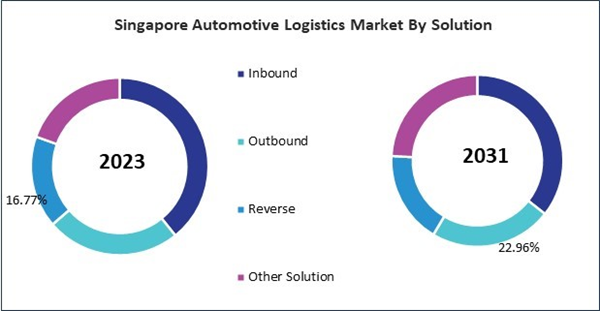The China market dominated the Asia Pacific Automotive Logistics Market by country in 2023, and is expected to continue to be a dominant market till 2031; thereby, achieving a market value of $40.28 billion by 2031. The Japan market is expected to witness a CAGR of 7.5% during 2024-2031. Additionally, the India market would register a CAGR of 8.8% during 2024-2031.
In China, green logistics policies encourage companies like BYD and Nio to adopt AI-driven route optimization and electric vehicle fleets for deliveries. Meanwhile, Japan’s Society 5.0 initiative integrates AI, IoT, and blockchain in logistics, improving efficiency while reducing environmental impact. Investments in smart infrastructure, such as Singapore’s Smart Nation initiative, which includes automated traffic management and IoT-enabled fleet tracking, are further transforming the industry. As governments, automakers, and logistics providers collaborate, the future of automotive logistics will become increasingly efficient, resilient, and sustainable, ensuring seamless supply chain operations.
Sustainability has become a growing priority in the automotive logistics sector, with companies striving to reduce carbon footprints, optimize fuel consumption, and implement eco-friendly practices. The adoption of electric trucks, hydrogen-powered logistics fleets, and renewable energy-powered warehouses is gaining traction as part of the industry’s commitment to green logistics solutions. Furthermore, circular supply chain models, which focus on recycling, reusing, and remanufacturing vehicle components, are widely adopted to improve resource efficiency and minimize waste. Governments and regulatory bodies are also introducing carbon taxation, emission reduction targets, and sustainable transportation incentives, pushing logistics companies to align with environmentally responsible practices.
Japan remains a major force in the automotive industry, producing 8.57 million vehicles in 2023 and serving as the home of renowned brands such as Toyota and Honda. The country's strong focus on hybrid and electric vehicles, supported by government incentives and environmental policies, has driven demand for advanced automotive logistics services. According to the Japanese Ministry of Economy, Trade and Industry (METI), hybrid and electric vehicles constitute a significant portion of new vehicle sales, requiring specialized logistics networks for EV batteries, advanced safety components, and lightweight materials. The increasing complexity of vehicle technology and global supply chain integration necessitates AI-driven fleet management, real-time tracking, and predictive analytics to optimize automotive logistics operations. Therefore, as automotive production and exports continue to rise across Asia Pacific, the demand for smart, efficient, and sustainable logistics solutions will drive rapid market growth throughout the forecast period.
List of Key Companies Profiled
- Kintetsu World Express, Inc.
- CMA CGM Group
- Deutsche Post DHL Group (The Deutsche Post AG)
- DSV A/S
- BLG LOGISTICS GROUP AG & Co. KG
- Imperial Brands PLC
- Nippon Express Co., Ltd.
- Hellmann Worldwide Logistics SE & Co. KG
- Schenker Storen AG
- Penske Automotive Group, Inc.
Market Report Segmentation
By Type
- Finished vehicle
- Automobile Parts
By Distribution
- Domestic
- International
By Activity
- Warehousing
- Transportation
- Roadways
- Maritime
- Railways
- Airways
By Solution
- Inbound
- Outbound
- Reverse
- Other Solution
By Country
- China
- Japan
- India
- South Korea
- Singapore
- Malaysia
- Rest of Asia Pacific
Table of Contents
Companies Mentioned
- Kintetsu World Express, Inc.
- CMA CGM Group
- Deutsche Post DHL Group (The Deutsche Post AG)
- DSV A/S
- BLG LOGISTICS GROUP AG & Co. KG
- Imperial Brands PLC
- Nippon Express Co., Ltd.
- Hellmann Worldwide Logistics SE & Co. KG
- Schenker Storen AG
- Penske Automotive Group, Inc.
Methodology

LOADING...









